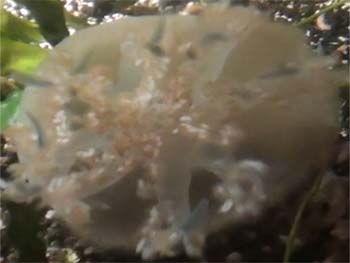| | | 
| Upsidedown JellyfishDescription of the Upsidedown Jellyfish
The Upsidedown Jellyfish is also known as the Upsidedown Sea Jelly or Jellies and is native to Florida. They have a mild sting which also causes an itchy red rash and vomiting. As their name suggests, they swim with their 'bell' facing down towards the ocean floor. Often these jellies are used by crabs for extra protection from predators, they are also often mistaken for a sea anemone. Did you know...A group of Jellyfish is called a smack!
|
| Picture of a Upsidedown Jellyfish | |
| |
Upsidedown Jellyfish
Facts - Information - Picture - Video Popular Name: Upsidedown Jellyfish
Species: Cassiopea andromeda
Profile of the Upsidedown Jellyfish
This Profile contains interesting facts and information about the Upsidedown Jellyfish species.
|
| |
Scientific Classification of the Upsidedown Jellyfish
Definition: Scientific classification, or biological classification, is how biologists group and categorize species of organisms with shared physical characteristics. Scientific classification belongs to the science of taxonomy.
Interesting Facts and Information - How do you identify the sex of a Upsidedown Jellyfish?
The males and females of many fish species have different colors or different shaped bodies. But there are also other fish species where there is no visible difference. Its sometimes tricky being an ichthyologist!
|
| |
|
Interesting Facts and Information - Why are Upsidedown Jellyfish slimy?
Upsidedown Jellyfish secrete a type of mucus, or slime, from their skin. This slime provides protection against parasites and infections and helps the Upsidedown Jellyfish to move through the water faster. Some fish species also release toxins in their slime which ward off enemy attacks. Other fish species use their slime to feed their young.
Interesting Facts and Information - Why do Upsidedown Jellyfish have gills?
Gills enable the Upsidedown Jellyfish to breathe. Gills consist of thin sheets of tissue containing blood vessels. As water passes over the gills oxygen is absorbed into the blood stream Carbon dioxide passes out into the water. The gills are protected by a large bony plate called an operculum. Some fish species however have lungs and breathe air.
Interesting Facts and Information - Why do the Upsidedown Jellyfish have fins?
A fin is an external appendage or "limb" of a fish. Fins are used for directing, stabilizing, or propelling the different fish species in water. Numbers of fins vary between fish species, but there are usually seven. Each of the fins on a fish are designed to perform a specific function:
|
| |
Pectoral fins. The Pectoral fin is located on the breast area of fishes. The Upsidedown Jellyfish has Pectoral fins to for locomotion and side to side movement.
Upsidedown Jellyfish
|
| |
|
Fish Species
|
|
|